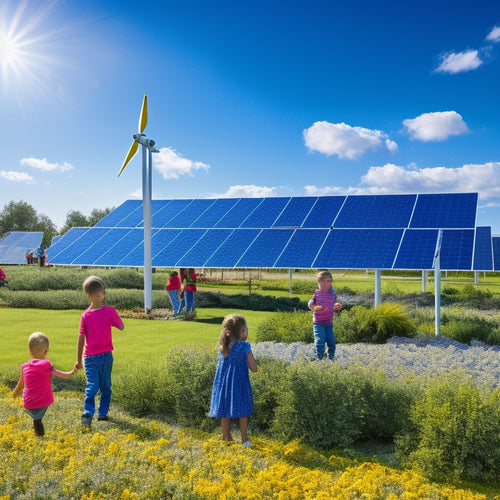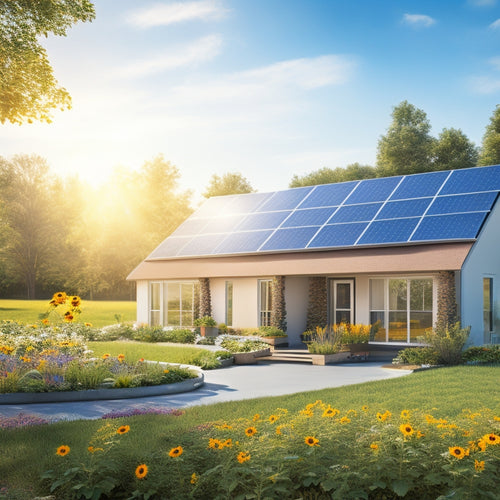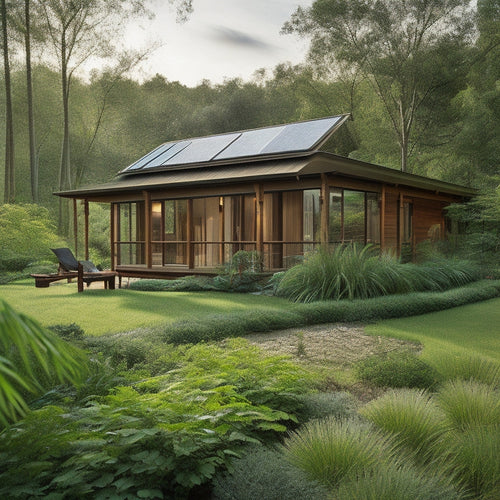
Installing Industrial-Scale Renewable Energy for Factories
Share
You're considering installing industrial-scale renewable energy for your factory, a strategic move that can greatly reduce your carbon footprint and operational costs. To get started, assess your factory rooftop's suitability by evaluating available space, structural integrity, and exposure to natural elements. Next, choose the right solar panel based on efficiency, durability, and compatibility with your energy requirements. Then, design a customized solar array that optimizes energy production while minimizing shading. Finally, factor in installation and maintenance costs, and guarantee energy efficiency gains by conducting regular energy audits and implementing energy-efficient solutions. Look ahead to overcome potential hurdles and maximize your renewable energy system's potential.
Key Takeaways
• Assess the factory rooftop's suitability for solar panels, considering available space, structural integrity, and exposure to natural elements.
• Choose high-efficiency solar panels that meet energy requirements, are durable, and have a suitable warranty.
• Design a customized solar array that optimizes energy production while minimizing shading and ensuring compliance with building codes.
• Accurately estimate installation and maintenance costs, including labor, permits, equipment, and ongoing expenses.
• Implement energy-efficient solutions and regularly audit energy usage to maximize the renewable energy system's potential.
Assessing Factory Rooftop Suitability
To determine the viability of installing industrial-scale renewable energy, start by evaluating the factory rooftop's suitability. Consider factors such as available space, structural integrity, and exposure to natural elements.
You'll need to assess the rooftop's condition, identifying any obstacles that could hinder installation, such as skylights, vents, or existing equipment. Structural integrity is essential, as the rooftop must be able to support the weight of the renewable energy system.
You'll also need to evaluate the rooftop's exposure to natural elements, including wind, rain, and sunlight. By considering these factors, you can determine whether the rooftop is suitable for industrial-scale renewable energy installation.
This evaluation will help you identify potential challenges and develop a plan to overcome them, ensuring a successful installation.
Choosing the Right Solar Panel
When selecting a solar panel for your industrial-scale renewable energy installation, you'll need to consider the panel's efficiency, durability, and compatibility with your factory's energy requirements.
| Panel Type | Panel Efficiency | Warranty Options |
|---|---|---|
| Monocrystalline | 20-22% | 25-30 years |
| Polycrystalline | 15-18% | 20-25 years |
| Thin-Film | 7-14% | 15-20 years |
You should evaluate high-efficiency panels (above 18%) for maximum energy output. However, these panels may come at a higher cost. Assess your factory's energy needs and budget to determine the most suitable panel type. Additionally, make sure the warranty options align with your project's timeline and maintenance strategy. By carefully evaluating these factors, you can select the right solar panel for your industrial-scale renewable energy installation.
Designing a Customized Solar Array
With your chosen solar panel in hand, you're ready to design a customized solar array that maximizes energy output while accommodating your factory's unique spatial constraints and energy requirements.
To begin, assess your factory's energy demands and available rooftop or land area for solar farming. Consider factors like panel orientation, tilt, and spacing to optimize energy harvesting.
Using specialized software, create a detailed layout that guarantees efficient energy production while minimizing potential shading and obstruction.
Validate that your design meets local building codes and regulations. By carefully planning your solar array, you'll be able to harness the full potential of solar energy and reduce your factory's reliance on non-renewable sources.
Installation and Maintenance Costs
Your total investment in a customized solar array includes not only the cost of the panels and supporting infrastructure, but also the expenses associated with installing and maintaining the system over its lifespan. When conducting a cost analysis, it's crucial to take into account these additional expenses for accurate budget planning.
Here are some key installation and maintenance costs to factor into your calculation:
-
Labor costs: The cost of hiring and training installation teams, as well as ongoing maintenance personnel
-
Permitting and inspection fees: Local permits, inspections, and compliance costs
-
Equipment and material costs: Inverters, mounting systems, and other necessary components
- Ongoing maintenance and repair costs: Scheduled maintenance, repairs, and replacement of components
Ensuring Energy Efficiency Gains
Optimize your renewable energy system's performance by identifying and addressing energy losses, ensuring maximum energy efficiency gains.
Conducting regular energy audits helps you pinpoint areas of inefficiency, allowing you to make targeted improvements. By doing so, you'll reduce your factory's carbon footprint and lower energy consumption. This, in turn, leads to significant cost savings and a reduced environmental impact.
Implementing energy-efficient solutions, such as LED lighting and smart sensors, can also help minimize energy waste. By taking a proactive approach to energy management, you'll be able to maximize your renewable energy system's potential and reap the benefits of a more sustainable operation.
Overcoming Potential Hurdles
As you navigate the process of installing industrial-scale renewable energy, you'll likely encounter several obstacles that can hinder your progress.
You'll need to contend with regulatory framework constraints that may limit your project's scope, technical integration challenges that require innovative solutions, and financial viability concerns that can make or break your project's feasibility.
Regulatory Framework Constraints
Inadequate or overly complex regulatory frameworks can hinder the development of industrial-scale renewable energy projects, forcing you to navigate a labyrinth of permits, licenses, and approvals. As you start on your renewable energy project, be prepared to overcome regulatory hurdles that can slow down your progress.
Some common challenges you may face include:
- Policy loopholes that create uncertainty and ambiguity
- Compliance burdens that require significant resources and manpower
- Lack of standardization across different regions and jurisdictions
- Inconsistent enforcement of existing regulations and policies
Technical Integration Challenges
When integrating industrial-scale renewable energy into the existing grid, you'll need to address several technical hurdles that can impede a seamless shift to clean energy. One major challenge is grid synchronization, guaranteeing that the renewable energy source's output frequency and voltage match the grid's requirements.
Failure to do so can lead to power quality issues, such as voltage fluctuations or frequency deviations, which can damage equipment or disrupt operations. You'll need to implement advanced control systems and monitoring tools to secure a stable and reliable power supply.
Additionally, you must also consider the potential for harmonics and electromagnetic interference, which can affect the overall power quality and efficiency of your renewable energy system.
Financial Viability Concerns
By investing in industrial-scale renewable energy, you'll need to navigate financial viability concerns that can make or break your project's success. It's crucial to carefully evaluate the financial implications of your project to guarantee its feasibility.
To mitigate financial risks, consider the following key factors:
-
Conduct thorough risk analysis to identify potential pitfalls and develop strategies to address them.
-
Develop accurate cost modeling to estimate project expenses and returns on investment.
-
Evaluate government incentives and tax credits that can offset project costs.
- Assess the potential for revenue streams from selling excess energy back to the grid.
Frequently Asked Questions
Can Industrial-Scale Renewable Energy Systems Be Used for Non-Manufacturing Facilities?
You can definitely utilize industrial-scale renewable energy systems beyond manufacturing facilities, particularly in office buildings and university campuses, where high energy demands can be greatly reduced with on-site renewable energy generation.
How Does Weather Condition Affect the Performance of Solar Panels?
You observe that weather conditions greatly impact solar panel performance, as cloudy days reduce energy output by up to 50%, while temperature fluctuations affect efficiency, with best performance typically occurring between 15°C and 25°C.
Are There Any Government Incentives for Industrial Renewable Energy Adoption?
You can leverage government incentives like Tax Credits and Green Bonds to offset industrial renewable energy adoption costs, as many governments offer these incentives to encourage sustainable practices and reduce carbon footprints.
Can Existing Electrical Infrastructure Support Industrial-Scale Renewable Energy?
"Ha! You think the grid's ready for industrial-scale renewables? Think again. You'll need significant Electrical Upgrades to boost Grid Capacity, or risk crippling the system. Are you prepared to foot the bill?"
How Long Does It Take to Break Even on an Industrial-Scale Renewable Energy Investment?
When evaluating an industrial-scale renewable energy investment, you'll want to calculate the payback period, analyzing financial projections and ROI to determine when you'll break even, typically ranging from 5 to 15 years, depending on investment timelines and market conditions.
Related Posts
-

Solar Power for Community Energy Independence
Solar power is essential for your community's energy independence, offering both environmental and economic benefits....
-

Home Solar Systems for Environmental Impact
Home solar systems markedly reduce your carbon footprint by utilizing renewable energy. By adopting solar energy, you...
-

Affordable Sustainable Building Materials for Homes
You can build an eco-friendly home on a budget by choosing affordable sustainable materials. Consider using reclaimed...


